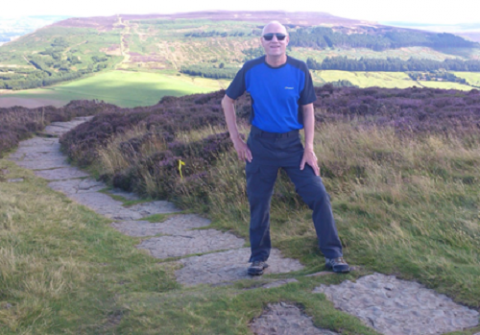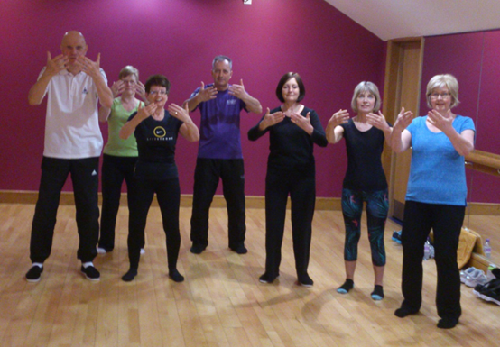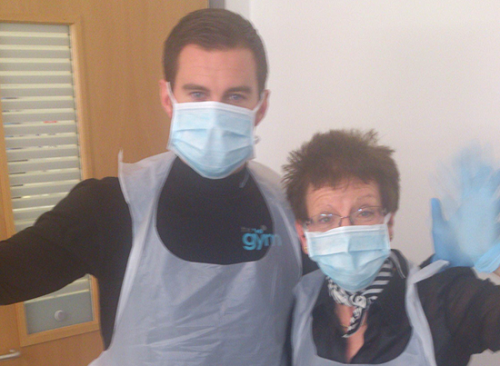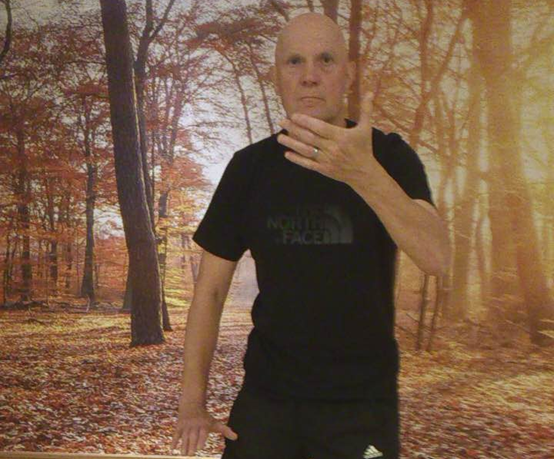In 2013, Peter had a bone marrow transplant to treat his acute myeloid leukaemia (AML). He spoke to Billie in the patient team about his experience, as well as how practicing Tai Chi has helped him during his transplant and in his long-term recovery.
Tell me about when you first became unwell.
It was 2008 and I had a stroke. I was getting lots of dizzy spells going upstairs, and getting red in the face. I thought, ‘Something must be wrong here,’ but you put things off.
One day I brushed past a radiator and I felt nothing, and my balance was completely shot – so we went to the hospital straight away.
As it turned out, the stroke happened because I had polycythaemia vera (PV) – a rare blood disorder – and I had to have a lot of blood letting to thin my blood to stabilise my condition.
10 % of people who have PV go on to have acute myeloid leukaemia (AML), which then becomes even harder to treat. But such a small number of people get PV, and an even smaller amount get AML, so you think, ‘That’s never going to be me!’
But in 2012, I sadly developed AML and was on watch-and-wait for about 12 months.
That must have been difficult to hear.
It certainly was. We went to a conference about PV at the life centre in Newcastle, and I asked a question about my condition. The speaker told me it didn’t look good, and my heart sank.
How old were you when you had your stem cell transplant?
I was 61. I was a bit concerned that my age might mean they might not want to go ahead with a transplant, because of the cost involved to the NHS and everything, but I was very fit for my age and that made a difference.
You don’t have any siblings, so you knew it was going to be an unrelated donor – were you kept informed during the search process?
To be honest, I didn’t pay much attention to it. They told me they were going to look for a donor and they found one fairly quickly for me – actually, in under three months – so that was marvellous.
I was very positive about the transplant from the off, though. There was never any doubt in my mind that it would work. I couldn’t allow myself to think like that.
Even if a little voice at the back of me was concerned, I was very focused. I thought, ‘Right let’s do this.’
There was no other option – well, the other option was death, so that wasn’t for me!
Have you always had that outlook? Is it the way you live your life?
Yes; I try and live as positively as I can. Tai Chi is a big part of that.
Can you tell me a little bit why you first became interested in Tai Chi?
I think I’ve always had an interest in it; when you see it on the television, when they are doing it in the park in China. I’ve always thought, ‘I could be interested in that.’ Eventually my wife and I sought out a class, and we started to go, and we really really enjoyed it.
Even though it is an internal martial art, they describe it as a ‘mind, body and spirit exercise’, and I feel that.
How do you think it benefited you during the transplant process?
Part of the Tai Chi we do is a standing meditation called Chi Kung: you stand in various postures, empty the mind, and visualise on any areas of the body that need attention. We do 15 minutes of mediation before we begin, warm-up exercises, and then begin on the form.
In the run-up to transplant, the fatigue got really debilitating, and I had to stop work. The Tai Chi meditation really helped me with that. I’d do it at home every day: visualisation. Thinking about my bone marrow, my blood cells, visualising my bone marrow being perfect, good white cells, good red ones, all balanced out. Just healthy.
Did you continue this daily practice during the isolation period?
Absolutely. I mean, you can feel a bit self-conscious when people are walking by, looking through the window, wondering what you’re doing! But it was important to me.
As you know, you can take two people around the same age who have the same illness, and one will survive and one won’t, and I believe something makes a difference. I believe in the mind/body connection, that the mind does influence the body.
Something that did cause me a bit of stress during that time was that my wife Judith had a chest infection, so she couldn’t visit, and my son Ritchie had a cold too.
For part of that time, I didn’t see a soul who I knew. So I turned to my practice.
And how do you feel after the transplant? Did you return to work?
I never went back to work after the procedure, I’m retired now.
I think since I’ve had the transplant and gone through all that, nothing really troubles me any more. You might hear people whinge and moan about little things and I think, ‘Heck, I’ve been through all that treatment, I’m not going to let this upset me.’ I think Tai Chi has given me a lot of inner peace.
When I was in hospital, I remember the doctor telling me that when I got home the fatigue would kick in. And I was like, ‘No it won’t, I feel great’ but it really did; it hit me like a hammer, and I could sleep for day’s which really wasn’t like me.
Out of the whole process, fatigue was the thing that bothered me most, and the lack of focus that comes with it, too. Another thing the Tai Chi practice was good for.
Would you say fatigue has been the lingering late effect for you?
Definitely. It still hasn’t fully gone, but for the first two years post-transplant, it was a difficulty for me.
You mentioned that you go to classes with your wife. Is that something you still keep up now?
We are going later today, actually! We go to 3 or 4 classes a week. Plus swimming and walking; I’ve a few hobbies as well as the Tai, which all influence you as a person.
Would you recommend Tai Chi to others having a bone marrow transplant?
I would; but any form of meditation, really, as it was probably more the meditative side of Tai Chi that helped me rather than the physical aspect.
So I would recommend visualisation exercises and a positive attitude. It’s a very difficult time to be positive, I know – but you’ve got to try, haven’t you?
Everyone is made differently; some might go into hospital feeling terrified and worrying about everything. But I kid you not, when I walked into the Freeman Hospital I thought, ‘Well, if I am going to go through this, I am going to enjoy it.’
That might sound crazy! that’s part of tackling it head-on.
And in the end, I wouldn’t say I enjoyed it by any means! *laughing* But I wouldn’t say I disliked it either. I think it changed me as a person for the better.
And what about your donor?
I did write to them to say thank you, but I didn’t hear back, and that’s OK. I know some donors want to do a good thing and then just get on with their lives.
You owe them everything, really, along with Anthony Nolan and all the health professionals that see you through it, cause without them, I wouldn’t be talking to you today.
For more information about wellbeing and recovery after a stem cell transplant, read and download 'Life After Transplant: An Essential Guide to Emotional Wellbeing.'



